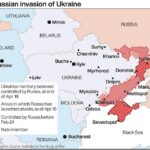
Russia shelled more than 40 towns and villages in the Donbas region, Ukrainian officials said Thursday, as Moscow intensified attacks in Ukraine’s industrial heartland and attempted to encircle key eastern cities.
Now in its fourth month, Russia’s war on its neighbor has increasingly zeroed in on efforts to overtake the Donbas and install pro-Moscow local governments and pro-Russian public displays in regions it controls, including around the key southern cities of Kherson and Mariupol.
The stepped-up attacks in the Donbas came as Russian President Vladimir Putin announced new initiatives to solidify Russian gains and potentially secure new ones.
Putin issued an order Wednesday to speed up Russian citizenship for Ukrainians in the Kherson and Zaporizhzhia regions. The move could further cement the Kremlin’s influence over the areas that form a strategic link between Russia and the Crimean peninsula, which Moscow illegally seized in 2014.


In a sign of its thinning military resources, Russian lawmakers also removed the the age limit — until recently 40 years old — on Russians signing up for voluntary military service to fight in Ukraine.
In an overnight video address, Ukrainian President Volodymyr Zelensky said the new age rules in Russia were a sign that “they no longer have enough young men.”
“But they still have the will to fight. It will still take some time to crush this will,” Zelensky said.
Zelensky also bristled at suggestions that Ukraine cede territory to end the war. Speaking this week at the World Economic Forum in Davos, Switzerland, former U.S. Secretary of State Henry Kissinger said Ukraine needed to give up claims to Crimea and parts of the Donbas in order to secure peace.
Zelensky said that “great geopoliticians” were ignoring “the millions of those who actually live on the territory that they propose exchanging for an illusion of peace. We always have to think of the people and remember that values are not just words.”
But Moscow said it expects Kyiv to recognize the reality on the ground and to accede to its demands, which have included recognition of pro-Russian breakaway areas of the Donbas. Kremlin spokesman Dmitry Peskov told reporters Thursday that the Ukrainian government “must acknowledge the de facto situation and just have a sober assessment of it.”


In the Donbas, which comprises the Donetsk and Luhansk regions, Kyiv-backed Luhansk Gov. Serhiy Haidai said in a message posted to Telegram that “more than 90%” of his region had fallen under Russian control. He said Severodonetsk and Lysychansk were the largest cities to remain in Ukrainian hands in the region.
While attention has focused on the grinding battle in the east, concern has also been rising as Russian troops advance toward the city of Zaporizhzhia, through what has been a key escape corridor for residents of Mariupol and other areas now ruled by Moscow.
Russian forces advancing from the south have been reported within 20 miles of Zaporizhzhia.
Nerves were on edge Thursday after three missiles hit Zaporizhzhia the day before in the most damaging strikes to date on the city. One death and a handful of injuries were reported. The attacks hit a downtown shopping center and a helicopter components factory, and destroyed more than a dozen homes in a residential district.
Amid a steady rain Thursday, distraught families gathered their charred belongings from the bombed-out homes, many of which face demolition. They piled what they could into cars and trucks that wove through the muddy lanes of the working-class neighborhood.
Ukrainian troops on a highway leading to Zaporizhzhia from the north diverted traffic away from a bridge that spans a dam on the Dnipro River. Officials feared that Russians missiles could hit the bridge.
“Yes, people are nervous, especially after these latest attacks,” said Denys Peschyhyn, a volunteer coordinator at a distribution center where people — many displaced from elsewhere in Ukraine — awaited handouts of food and clothing. “But it is not a question of panic. Zaporizhzhia will fight.”
The war in Ukraine, which began Feb. 24, has displaced more than 11 million Ukrainians and united global powers against Putin. According to the Office of the United Nations High Commissioner for Human Rights, about 4,000 civilians have been killed and more than 4,500 injured since February. The agency says the figures are likely undercounts.
Life in Russia has worsened as well under the effect of international sanctions. On Wednesday, Putin ordered a 10% increase in pensions and the minimum wage in order to combat inflation, acknowledging on television that 2022 would be a “difficult” year but denying that the hardships were connected to Russia’s economic isolation as a result of the war. On Thursday, the Russian central bank also lowered its interest rate from 14% to 11%.
Russian oil exports continue to flow to the European Union, although the bloc has debated banning them for weeks. Hungary, an EU member state, has resisted the proposal.
Meanwhile, a historic shift by Finland and Sweden to apply for membership in the North Atlantic Treaty Organization has also run into resistance from Turkey, which has taken a stance against their membership.
McDonnell reported from Zaporizhzhia and Kaleem from London.
This story originally appeared in Los Angeles Times.




